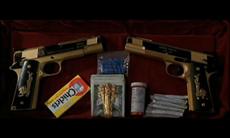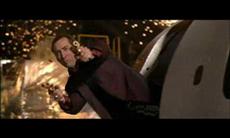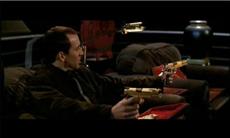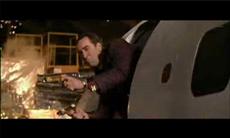Introduction Prior to the popularization of the action sequences seen in these Hong Kong films, the use of two pistols simultaneously, as well as any fancy gun-play, was limited essentially to the Western-genre films of yesteryear. No-one – not Gibson, Willis, or Arnold – ever picked up twin pistols in anger before this period in modern film history. Fast forward to today, some two decades after the beginning of the first modern HK action films, this kind of gun-play is now almost de rigueur. A modern action hero or villain is expected to be able to handle a pistol like a samurai would his sword – be it tossed-to or kicked-over, he’d better be able to snatch his weapon out of thin air and spread bloodshed and chaos. What’s more, he’d better be able to do so with a pistol in each hand. Everyone from Leguizamo to Denzel to Costner has dueled with a fancy, customized set of twin hand-cannons. But of course, as befitting the genre, no screen-characters do this better than Woo’s. Chow’s John/Dumbo in The Killer and Tequila in Hard Boiled held off virtual armies with a pistol in each hand. So did Cruise’s Ethan Hunt in MI-2 – no task was too delicate or too large for a pair of Berettas to handle. But in as much as these characters’ athleticism and grace were mirrored in their choice of weapons (spurring the sales of twin Western Arms Perfect Version Beretta M92FS and Centurion GBBs to many airsoft skirmish gamers), the full potential of the twin-pistol genre remained mostly unrealized. The true screen-power of dual handguns was first tapped in Woo’s Face/Off -- a flash of golden gunmetal behind the back of Cage’s Castor Troy. Such customized handguns are not new to the Silver Screen. The Westerns’ of yore routinely featured finely crafted firearms. Similarly, Hollywood today is also populated by a set of firearms enthusiasts serving the role of not only armorer/master-at-arms, but also even in the role of directors/producers…and even film stars. Jerry Lewis and Dean Martin’s quick-draw technique wasn’t all just song-and-dance, and even today, this kind of focus on how a firearm and its use may be linked to the overall screen-characters’ credibility is not overlooked by actors even as young and popular as Taye Diggs, Benicio Del Toro, or Ryan Phillippe. The flair and flavor of the weapons must match that of the screen-characters’. And that gorgeous pair of 1911-.45s in Face/Off currently serves as the proverbial gold-standard for this rule.
The interest in the twin golden .45s has been nothing short of phenomenal. Visit any of the Internet airsoft Forums, and you’ll see that hobbyists, collectors, and even skirmish players – literally world-wide – have been actively pursuing these replicas. US, UK, Iceland, Finland, Japan, Hong Kong – it doesn’t matter where you look; if there’s discussion about gas-blowback replica handguns, you’ll find talk about the Castor Troy pistols. So what does a boy have to do to get his paws on a pair of these replicas? I. The full-build -- The easiest – albeit also possibly the most expensive – way is to fork over the $4800 or so (US Dollars, and that’s without shipping!) to the famed Sheriff Co., Japan, airsoft custom-house. What you get in return is a pair of fully-built Springfield Custom Distinguished Limited Movie replicas aptly named the “Movie Special.” Using Sheriff’s proprietary Titanium Coat (TiN ion-coat – which can be seen in this picture, and also is further demonstrated here) finished in a deep 24k gold shade (a $400 option in and of itself, on a customer-supplied Sheriff slide) with full Springfield trademarks and inscriptions (available on the frame only when one purchases a complete, full-build GBB from Sheriff – otherwise, it’s just the slide that gets the treatments on a cost-per-inscription basis) , this is about as close as you can come to the movie pieces in a plug-and-play format. The only differences from the twins seen in the movie are the grip panels, which here are black Zytel (instead of the inlaid wood), and the use of Novak/Wilson Combat #463 Series Tactical Combat Sight replica rear sight units (instead of the BoMar on the guns seen in the movie). A near-perfect piece – for a very dear price. That kind of a budget, however, is typically only within the realm of the well-endowed collector, the filthy rich, or just the outright bat-crazy….. Luckily, there are other options available. II. The DYI -- Foremost among these options: you can simply try to build your own. Look at those same Internet hobbyist websites and you’ll see discussion threads filled with an abundance of such project ideas (please see the “External Links” section of the references included below). What’s more, there have even been some very detailed full-out projects, such as that by the UK WA GBB guru Mobius Strip, which have gained world-wide fame. These projects all are indebted in-part to an ever-growing list of readily and easily available “over-the-counter” aftermarket parts that have come to-market over the past few years and which are getting more and more cosmetically detailed and specialized for just this application. Currently, it is actually quite easy to locate the most critical component – the slide. Sheriff, Perversity Guns Corporation (PGC), GRS, and Shooter’s Design (SD/DEN) all make different Springfield Armory trademarked aftermarket metal slides in all sorts of different finishes and with varying details. Depending on user-preference, you can get the Springfield Armory crest placed at different locations, Custom Shop slides, different combinations of cocking serrations, barrel bushing use, and even different rear sight cutout types. With a budget anywhere between a high of $500 (including special refinishing – however, keep in mind that true “custom” slides can go up in price into the thousands of dollars!) to a low of $120, one can quite easily purchase a slide to fit whatever unique and special needs he or she may have. And if the gold finish is more important to you, then Guay Guay (G&G) offers a “gold” polished SVI-type “fish scale” cocking serration equipped slide. Or if you simply desire the compensated look, the PGC “Japan Set” for the Springfield Custom integrates a V-12 ported bull/cone/”corn” outer barrel matched with a port-cut slide. Just as this critical part is readily available from the larger HK retailers such as DEN Trinity, WarGamers’ Club Shop, UN Company, RedWolf, etc. (and therefore by extension also the main US high-end retailers like AirsoftToys and AirsoftExtreme, as well as specialty resellers, such as Olympus Airsoft), other main components, such as the outer barrel, recoil spring guide rod, ambidextrous safeties, beavertail grip safety, and so on can all also easily be had from those very same sources. But yet, there are also certain problems. Among these headaches are the biggies of first locating the proper type of retrofit slide in order to guaranty usability with what is typically the Western Arms 1911-type GBBs as their base-frames – chiefly, the availability of slides as well as outer barrels that have received the Springfield V-Comp cuts and porting is distinctly limited (currently, with PGC’s “Japan Set” being the only retail option in this respect, but provides its own problems with respect to rear sight use). And, of course, the cosmetic finish of the slide also remains problematic. And this is what accounts for most of the differences for the current Face/Off projects that have come to bear – instead of slaving for an exact replica, hobbyists/enthusiasts have instead chosen to put their own touches on such dedications through a combination of both need (from the inaccessibility of certain parts and accessories) as well as out of their own aesthetic creativity. I am no exception to this – I also created my Springfield Customs out of those very same constraints and also out of my desire to pay tribute to Face/Off in a manner that does not specifically replicate the twin gold .45s.
As its name suggests, these WA GBBs are single-stacker SVIs in the best traditional 1911-vein. A full sized 5” Government Model chassis is mated with a traditional partial dustcover, traditionally profiled slide, and round trigger guard. Add to that a distinctly modern twist in the form of a contrasting silver color plated beavertail grip safety, ambidextrous wide slide/thumb safeties, adjustable SV trigger assembly, as well as a full-length recoil spring guide rod, a bull/cone/”corn” barrel, and BoMar adjustable rear sight aperture – what you get is a faithful yet unique re-creation of a single-stacker, Strayer Voigt Traditional 1911 IED as seen here. At 925 grams in stock form, this GBB is no flyweight. For the uninitiated, it can be relatively disconcerting and distinctly fatiguing to shoot one handed. However, easing this are the usual WA single-stacker format grip frame weight plates, which shift the center-of-mass of the piece to favor the grip itself. Unlike the real-steel, of which the barrel constitutes a heavy weight until a fully loaded magazine is inserted, the replica is distinctly non forward-biased. Thus, general arm strength, rather than forearm/wrist strength, is all that’s required to heft and aim these pieces Otherwise, ergonomics are much the same with this piece as with any other single-stacker 1911-variants dished out by Western Arms. For those familiar with the beefy feel of the double-stackers, the single stacker, with a grip that’s nominally only about ½ inch to 1 inch “thinner” than that of its higher-capacity counterpart, proves to be quite a bit more ergonomically pleasing for most users due in large part to its more softly contoured edges rather than to any true differences in overall grip size. However, for those who cut their teeth in airsoft skirmish combat with the much more anatomically appropriate grips of the SIGPROs and Walther P99s, or even that of the Glocks and Berettas, the traditional 1911 grip will likely feel quite flat and “slab-sided.” Meanwhile, although the slide safety remains easily accessed by the thumb of the shooting hand, these GBBs still retain the traditional 1911 design and dimensions regarding actuation of its main control surfaces. Most notably, the magazine release requires a slight shifting of the hand to actuate for all but the largest-pawed shooter. And of course, the slide stop/lock-release requires either a full shifting of the shooting hand to trip, or, according to more correct procedures, will require the support-hand thumb to engage (in a one-motion that completes the magazine reload-process, as it comes up to support the pistol). However, a modern 1911 isn’t necessarily an ergonomic nightmare. The high-ride beavertail is a welcome addition. It allows a very firm, high-grip of the GBBs chassis without any fear of the .45-trait of web-pinching from the hammer. Meanwhile, where the trigger meets the finger reveals the typical SVI interchangeable trigger shoe design, offering the shooter the ability to tailor the trigger itself to their own taste. And up-top, a set of highly defined traditional three-dot ironsights provides easy target acquisition – with the rear blade insert even featuring a Wilson Combat “Combat Pyramid”-type beveled-cut relief, automatically guiding your eyes toward the front sight and the setup of a proper sight picture.
And of course, it is to this last aspect – the safe/durable continued use of higher-powered gasses in order to insure and/or boost skirmish-capable performance – that in large part drives the lust for upgrades that’s so commonly seen with hobbyists and players today. This is also what serves as the basis for the cosmetic upgrades needed for a proper Face/Off tribute.
But with a heavier slide (unlike Sheriff’s or even SD’s offerings, this piece is beefy, and on the order of PGC’s in terms of adding mass to this critical area) as I’ve stated countless times on-line in the Forums and specifically presented in my “BB-IPSC” article, what’s also needed are some additional small-parts upgrades – all aimed at boosting slide cycle speed. .
With such a goal in-mind, installed in this pair of replicas are a set of Guarder/IS 150% recoil springs to speed return-to-lock/battery. Overcoming this additional forward drive is a 150% mainspring hybridized with Sheriff’s unique mainspring spacer assembly, which is then paired with a PGC “enhanced” (slightly extended) firing pin to help reinforce the blowback aspect of the cycle. Cosmetically, the stock high-polished, full-length two-piece WA recoil spring guide rod was retained, and I further surface re-finished and rust-proofed (Rust-Oleum Premium High Gloss Crystal Clear Enamel) a set of Sheriff steel mainspring housings in a black/silver pattern to continue the ongoing color scheme.
Countering the higher tension within the mainspring housing and subsequent higher trigger pull weight are basic modifications to the trigger bow, sear spring, and mainspring assemblies to slightly lessen trigger poundage. This is further aided through the installation of a set of PGC "Wilson Combat"-type bearing steel hammers with matching precision-cut sears and a PGC hammer strut. Polishing of the main contact components is an important step that no one should overlook, and further helps reduce operating friction, decrease lock-time, and also helps better overall subjective trigger feel. Here, caution should be taken to simply polish and remove burrs, not to actually remove critical material needed to achieve proper sear and hammer function, which is a common newbie mistake. At the other end of the GBB, a Guarder/IS “5-inch” stainless steel bull/cone/”corn” outer barrel (with full faux rifling) was mated to a high-polished. rust-proofed, and clearance-cut Sheriff “Barsto .45 ACP” steel faux/outer chamber (cover). Considerably heavier than either of their respective metal and plastic WA-OEM stock counterparts, these aftermarket pieces lend considerable heft to the GBBs, and helps to add a favorable muzzle-weighted feel to the replicas that enables greater accuracy on-target. Running through the length of the Guarder/Sheriff barrel is the stock WA Hop-enabled true chamber assembly with stock WA 6.08 mm bore, 108 mm long inner-barrel. But for duty in the upgraded GBB, the inner-to-outer barrel interface is stabilized by a Guarder/IS metal inner-barrel bushing at its forward junction. As these GBBs are required to function reliably under any and all skirmish conditions, the exacting and highly demanding nature of a tightbore inner barrel was sacrificed for ultimate feeding reliability. Similar to the simplified trigger job, the highest goal for this pair of GBBs is to achieve a reliable cycle, without fail, under ALL gaming conditions. As such, cutting-edge performance is sacrificed in-trade. At the base of the GBBs, a set of real-steel Wilson Combat #188 extended magwells in bead-blasted blued finish were installed (which required relief-cutting of the stock WA grip frame in order to achieve proper fit) to help balance the overall slide-vs.-frame proportions. Functionally, however, they also further ease magazine reloading by helping to funnel slightly misguided mags, which is a distinct possibility during hurried dual-gun reloads. And as each of my mags are fitted with some form of extended base-pad/”slam pad” (everything from stock WA-Wilson Combat magazines to custom cut-and-fitted genuine Wilson Combat #47BN base plates), proper clearance for mag insertion presents no problems.
Cosmetic parts aside, the mechanical modifications made boosts these WA 1911 single stackers to a totally different playing field in terms of observed muzzle velocity/energy as well as cyclic rate. The typical “weight lag” in cycle speed reported with stock WA heavyweight slides is completely eliminated. At the same time, the final muzzle energy approaches that of a WA double-stacker’s when on higher-powered Taiwanese “Green Gas” (appx. 1.0-1.1 Joules, or around 330 fps. with 0.20 gram BBs – confirmed current muzzle velocity/energy under 50 deg. F. testing conditions is a consistent 305 fps. with 0.20 gram BBs, verified via a Shooting Chrony F1 chronograph), ensuring capable field-performance. With comparable grouping as a typical stock inner-barrel equipped WA double-stacker (2-2.4 inch grouping at 5 meters; with proper Hop adjustment, easily capable of center-mass shots at 70+ ft.), these are a formidable pair of skirmish pistols. And with a price-tag of around $700, each, when all’s said and done, they’re not bad bargains at all for a set of high-performance and cosmetically unique replicas in the vein of Castor Troy’s flashy twins. This is especially true considering that just about anyone who can use a screwdriver, has at least some basic mechanical knowledge/aptitude, and can follow the mountains of advice and instructions provided on-line (much of which is cited below in the “References” section) can readily and easily build/tune themselves just such a quality piece! Face/Off
and the represented characters are copyrights of: Paramount /
Touchstone Pictures
|
























